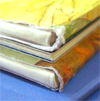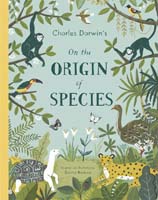|
|
|
|
|
|
|

| 최근 이 책을 구매하신 다른 회원의 책장 |
|
 |
|
|
|
[ 책 소개 ]
인류 문명사에 거대한 전환점을 가져 온 찰스 다윈의 위대한 책 "종의 기원"은 어른이 읽어도 이해하기 어려운 복잡한 책입니다만, 저자인 사비나 라데바가 아름다운 일러스트레이션과 함께 어린아이들도 쉽게 이해할 수 있도록 만들었습니다. 국내에서는 "어린이를 위한 종의 기원"이란 제목으로 번역서가 출간되었습니다.
찰스 다윈은 멀리 항해를 다니며 화석을 채집하고, 다른 장소에 사는 다양한 모습의 생물을 관찰하고 연구하여 자신의 이론을 체계적이고 상세하게 정리하였습니다. 1859년에 출간된 "종의 기원"에는 생물이 맨 처음 생명체에서 어떻게 지금의 모습에 이르게 되었는지, 어떻게 지구상에 이토록 다양한 생물이 존재하는지, 생물들은 어떻게 변이했는지 등이 모두 담겨 있지요.
쉽지 않은 내용이라 어린이를 위한 그림책으로 소개된 적이 없는데, 이 책은 어린이 눈높이에 맞춰 쉽고 재미있게 풀어써서 어린이들도 얼마든지 진화론을 이해할 수 있게 했습니다. 150여 년이 넘는 오늘날에도 최고의 고전으로 여겨지는 "종의 기원"을 그림책으로 만난다면 아이들도 놀라운 자연 세계의 수수께끼를 흥미진진하게 풀어나갈 수 있을 것입니다..
이 책은 원전의 제목을 그대로 차용하여 순서대로 차근차근 정리해 놓은 데다 쉬운 예시를 그림과 함께 설명하여 어린이들도 자연 세계의 원리를 쉽고 재미있게 이해할 수 있습니다. 더불어 최근 과학의 발전으로 진화론이 수정된 부분이나 새로 밝혀진 사실 등도 정리되어 있어 진화론의 전부를 꿰뚫게 해줍니다. 어린이만이 아니라 청소년과 어른도 진화론의 핵심적인 내용을 쉽게 만나는 계기가 될 것입니다.
큰 사이즈의 튼튼한 | 닫기x |  What is 하드커버? What is 하드커버?
양장본이라고도 불리우며, 표지가 단단한 판지로 만들어진 책입니다.
판지를 천이나 가죽으로 감싸기도 합니다. 책의 속지는 일반적으로 중성처리된 종이(Acid-free paper)를 사용해서 잘 변질이 되지 않기 때문에 오랫동안 보관하기에 적합합니다. 이 종류의 책은 더스트 재킷, 또는 더스트 커버로 불리는 표지덮개가 함께 있는 경우가 많습니다. 간혹 내부 속지가 콩기름 코팅이 된 경우 고약한 냄새가 나는 책도 있습니다.
|
[ 관련 동영상 보기 ]
 ▶
[ 서지 정보 ]
Hardcover: 64 pages
ISBN-10: 1984894919
ISBN-13: 9781984894915
책 크기: 28.7 cm x 22.7 cm
[ 영문 서평 ]
Book Description
A picture book adaptation of Charles Darwin's groundbreaking On the Origin of Species, lushly illustrated and told in accessible and engaging easy-to-understand text for young readers.
On the Origin of Species revolutionized our understanding of the natural world. Now young readers can discover Charles Darwin's groundbreaking theory of evolution for themselves in this stunning pictur
| 닫기x |  What is What is | 닫기x |  What is e-book? What is e-book?
전자책(electronic book)이라고도 불리우며, 책의 내용을 종이가 아닌 컴퓨터 모니터나 핸드폰의 화면을 통해 읽을 수 있습니다.
|
전자책(electronic book)이라고도 불리우며, 책의 내용을 종이가 아닌 컴퓨터 모니터나 핸드폰의 화면을 통해 읽을 수 있습니다.
|
| 닫기x |  What is e-book? What is e-book?
전자책(electronic book)이라고도 불리우며, 책의 내용을 종이가 아닌 컴퓨터 모니터나 핸드폰의 화면을 통해 읽을 수 있습니다.
|
Booklist *Starred Review*
"A beautiful introduction to a complex topic.”
School Library Journal
Charles Darwin published On the Origin of Species in 1859. This copiously illustrated adaptation uses accessible language to explain selected concepts from Darwin's work. Radeva successfully emphasizes Darwin's curiosity and observations of nature, changing the order of Darwin's original volume to add clarity. Examples of topics covered from the original work include natural selection, species struggle for existence, nature's effects on variations in species, and the influence of domestication on species. Direct quotes from Darwin's book are set apart from the main text with a different font. Minimal details document Darwin's personal life and his nearly five-year voyage on the HMS Beagle. Those gaps are covered in Peter Sís's The Tree of Life and Rosalyn Schanzer's What Darwin Saw: The Journey That Changed the World, both of which are listed as recommended reading. Another useful appendix identifies corrections to particular Darwinian ideas that have become outdated. The stylish artwork in muted greens, yellows, and browns with accents of red, orange, and black are filled with a range of vegetation and animals. The amount of page space devoted to the artwork varies, and the size/scale of the images change. VERDICT This informational picture book may fill the needs of upper primary teachers seeking supplementary materials to introduce Darwin's theories. Could also appeal to children with an interest in nature and librarians looking for fresh, simpler titles pertaining to Darwin's ideas.
Publishers Weekly
Radeva introduces the story of evolution through accessible, picture-filled spreads. “Since life on Earth began, tiny organisms, plants and animals have been changing slowly, over millions of years.” The text briefly presents a smartly suited Charles Darwin, his journeys aboard the HMS Beagle, and the observations that resulted in the publication of his magnum opus. Animals shown in chalky, stylized art (Radeva takes a primarily nonnaturalistic approach) are used to illustrate complex concepts such as species, variations, competition, and natural selection. One spread depicts gray wolves in an ornately rendered nighttime forest opposite several domesticated dog breeds. Quotes from Darwin are also integrated throughout. While the book may not help readers fully grasp the incremental nature of evolutionary change, it is a welcome primer on the topic.
Kirkus Reviews
An introduction for younger readers to the major ideas in a seminal work of science.
Radeva, a graphic designer with a background in molecular biology, uses a combination of simply phrased statements and short quotes to boil down Darwin's main notions about variety among both wild and domesticated animals, the struggle for existence that drives the process of natural selection, the development of instinct and of complex organs over long spans of time, and the anatomical resemblances in seemingly disparate species that point to common ancestries. Studiously avoiding mention of religion ("For most of human history, many people believed that everything on the world was created all at once"), she sketches out the genesis of Darwin's thesis with nods to Buffon and Lamarck, brings his theories up to the present with discussions of epigenetics and other recent evolutionary insights, then closes with rebuttals to select "Misconceptions" about Darwinism's precepts. Opening and closing with dozens of labeled butterflies and other insects on the endpapers, the illustrations feature gatherings of naive-style flora and (mostly) fauna, drawn in minimal but precise detail and lit with bright, clear colors. Human figures--beginning with Adam and Eve in leafy garb and ending, except for a few vignettes, with an evolutionary line leading up to the white-bearded scientist himself--default to white. |
|
|
|
|
|
|
|
|